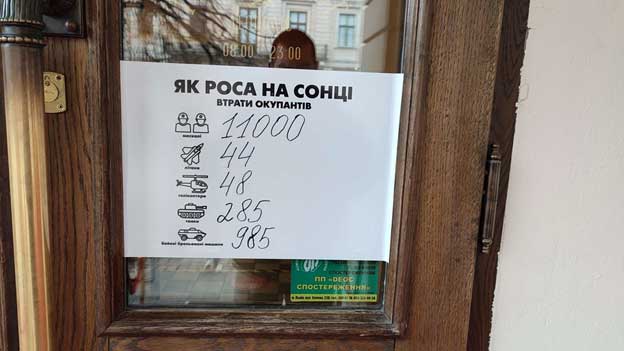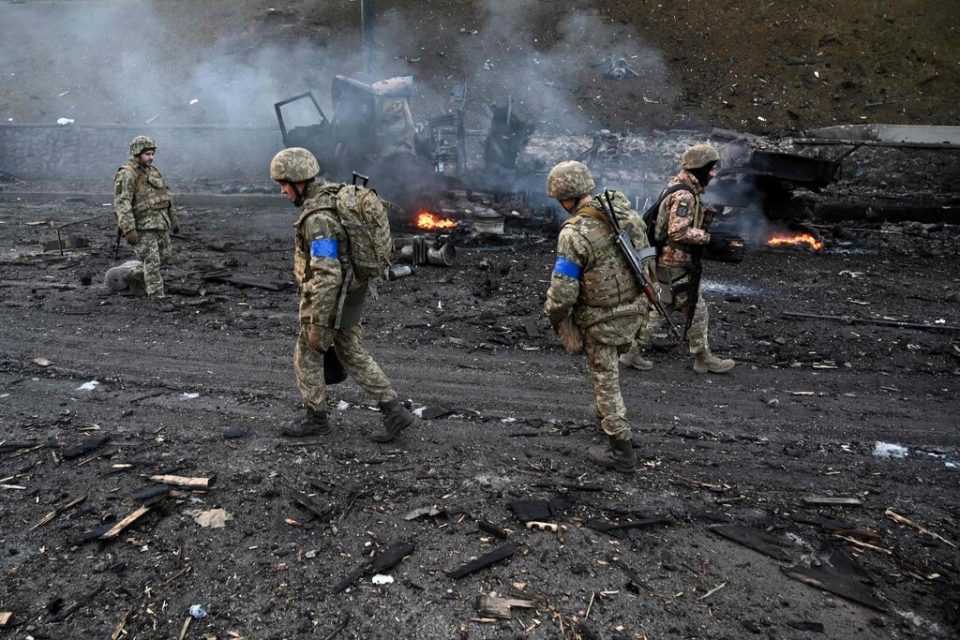LVIV, Ukraine – For a visitor walking into the Armenian Cathedral of Lviv, the first thing that will attract his attention is the graphic fresco depicting the beheading of St. John the Baptist, made by Jan Henryk Rosen, in early 1900’s.
What stands out more than the graphic nature of the scene, is the look on the face of the angel holding St. John’s severed head, he is angry. Usually, in Orthodox churches’ murals, even in scenes of violence, saints and angels are always depicted having a calm face, never angry.
“Look at their face, they are so defiant,” said Katia*, an Ukrainian activist from Kiev and Maidan veteran, who showed us around the city.
Defiance and anger are maybe the words that best describe the emotional state of the Ukrainians during the Russian invasion of their country. This is evident with a walk around the city of Lviv, in western Ukraine.
Many restaurants and coffee shops hang on their front door the daily report with the Russian casualties, while others check the passports of the customers entering to make sure they are not Russians.

A paper with the Russian casualties on the door of a Lviv café, March 2022, Credits: Aris Dimitrakopoulos
At the same time, hundreds of children, youngsters and pensioners gather every day in a city library to make camouflage for the Ukrainian army and Molotov cocktails to be used against the Russians.
On the first floor, one can find hundreds of people of all ages cutting green, gray and brown clothes into strips. On the second floor they take these strips and hang them on to the nets.
“We can’t sit and do nothing, people that can’t bear arms come here, these are all civilians volunteering,” says Vlad one of the senior volunteers.
“A lot of businesses donate these clothes, there are only certain colors that can be used.” he adds.
Sasha, a young painter who also volunteers, informs me, that this is happening all over the country.
“It’s all over Ukraine, people gather in schools and make this camouflage,” she notes.
The place is also full of children’s drawings, which are also going to be sent to the front.
“When we give the nets to our soldiers we put letters and paintings of children in them, to give them strength,” Sasha explains.

Molotov cocktails and children drawings in Lviv, March 2022, Credits: Aris Dimitrakopoulos
When I comment on how impressive it is that so many people actively contribute to the war cause, she pauses.
“Ants” she says, “It’s like ants, young and old, if you can do something with your hands you are here, this is our strength.”
This is only a small sample of the mobilization of Ukrainian society. Lawyers, athletes, mechanics and architects turned into soldiers overnight and rushed to man checkpoints, while women, children and the elderly contribute to the war effort in any way they can.
But, is this herculean effort enough for Ukraine to win the war?
Although the Russians are suffering heavy casualties in men and equipment, they are still advancing, while Ukrainian forces are unable to launch any large scale counter attack. Even if the situation on the ground stayed as it is today, Ukraine would have lost its access to the Sea of Azov and a big chunk of its Black Sea coastline.
This means that if a new peace agreement is going to be signed, it will surely be much worse for Ukraine than the Minsk agreement. So what went wrong?
Russia, as the party that launched the invasion, obviously carries the main responsibility for this war, but one cannot overlook the responsibilities of the West and the post-2014 Ukrainian leaderships.
President Zelensky, during the weeks preceding the war, constantly downplayed the threat of a Russian invasion, even joking about it ten days before it happened. As a result Ukrainian society was caught completely off guard.
“We didn’t expect that to happen, when Americans were saying that we were just…, we should have been more prepared but what can you do, just have your things packed?,” Maria, a schoolteacher from Zaporizhzhia tells me on a train ride from Poland to Germany.
Moreover, from 2014 until today, Ukraine’s post Maidan governments’ goals, accession to NATO and the EU, were never close of being realized, as the West never seriously discussed the matters because of the Russian casus belli and the threat of a nuclear confrontation.
Even now, while Ukrainian cities are raised to the ground, and thousands of Ukrainians are getting killed for their right to associate with the West, both NATO and the EU remain cold on the prospect of Ukraine joining.
EU leaders ruled out any chance of fast track membership for Ukraine, while NATO’s Secretary General on lack of a better response said that it’s “for the Ukrainians to decide”(sic) if they want to join NATO!
The implementation of a “no fly zone” over Ukraine that President Zelensky has desperately asked countless times has also been rejected by NATO and the US. The proposal of sending modern Polish fighter jets to Ukraine was also shut down.
While nobody can blame the West for not willing to risk a nuclear war, the Russian stance towards Ukraine and NATO expansion was well known even before 2014 and became clearer after the annexation of Crimea and the Donbas War.
So, why the West continued this policy of pseudo-backing Ukraine?
Leaving the EU and NATO door “open” for Ukraine rhetorically while at the same time keeping it practically closed achieved the worst of both worlds; Kiev gained confidence but in reality remained alone, while Moscow remained agitated.
As a result, Ukraine, within eight years, went from fighting for an association agreement with the EU to fighting for its right to be an independent state. If this is not a total failure then what is it?
“Someday this war is going to end” said Rubert Duvall in his famous line as Lt. Colonel Bill Kilgore in Francis Coppola’s “Apocalypse Now”.
And when “someday” arrives for the war in Ukraine, the West will have to explain to Ukrainian people how this eight year struggle that cost thousands of lives and ended in this tragedy for them was worth it.
Republished from Modern Diplomacy

